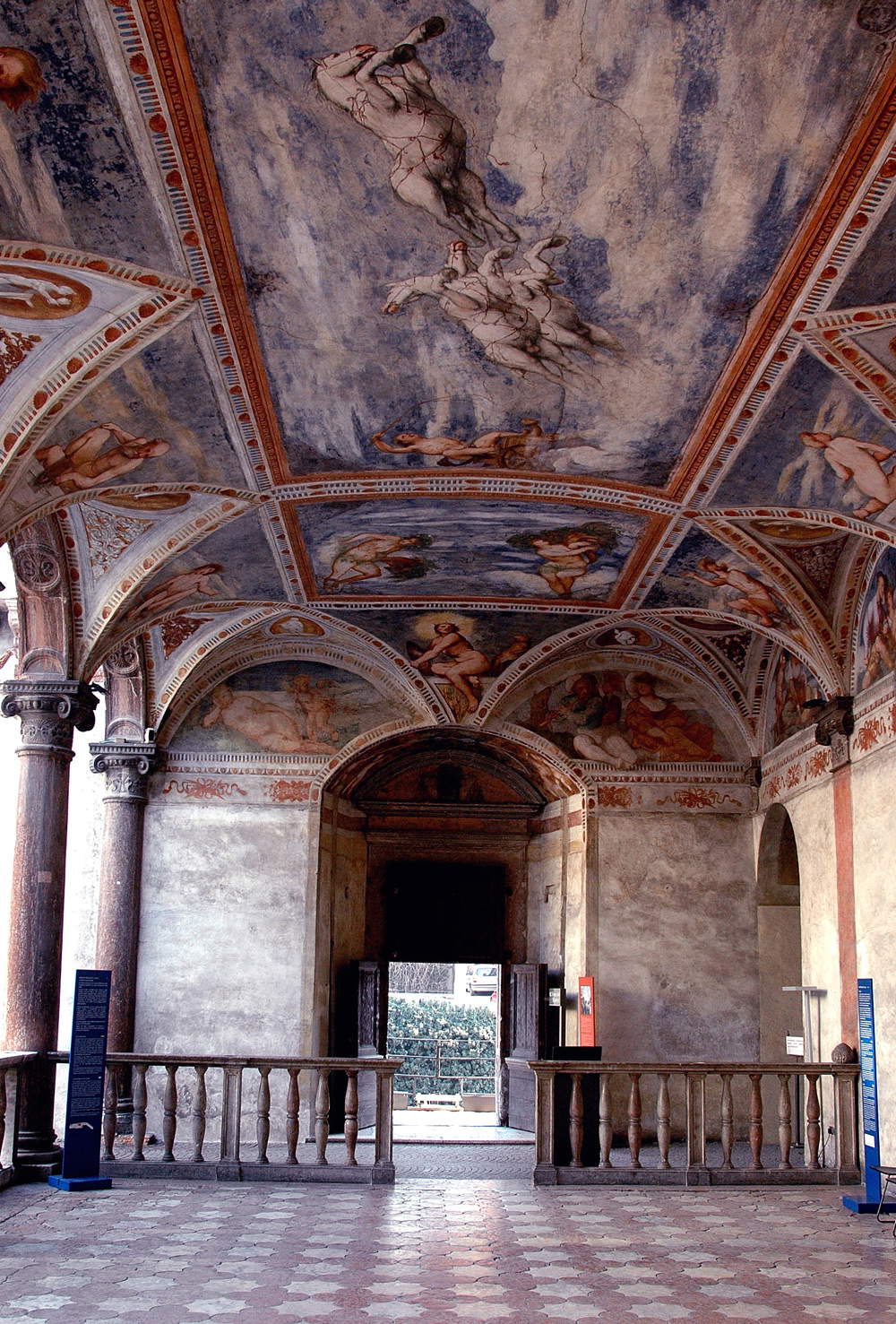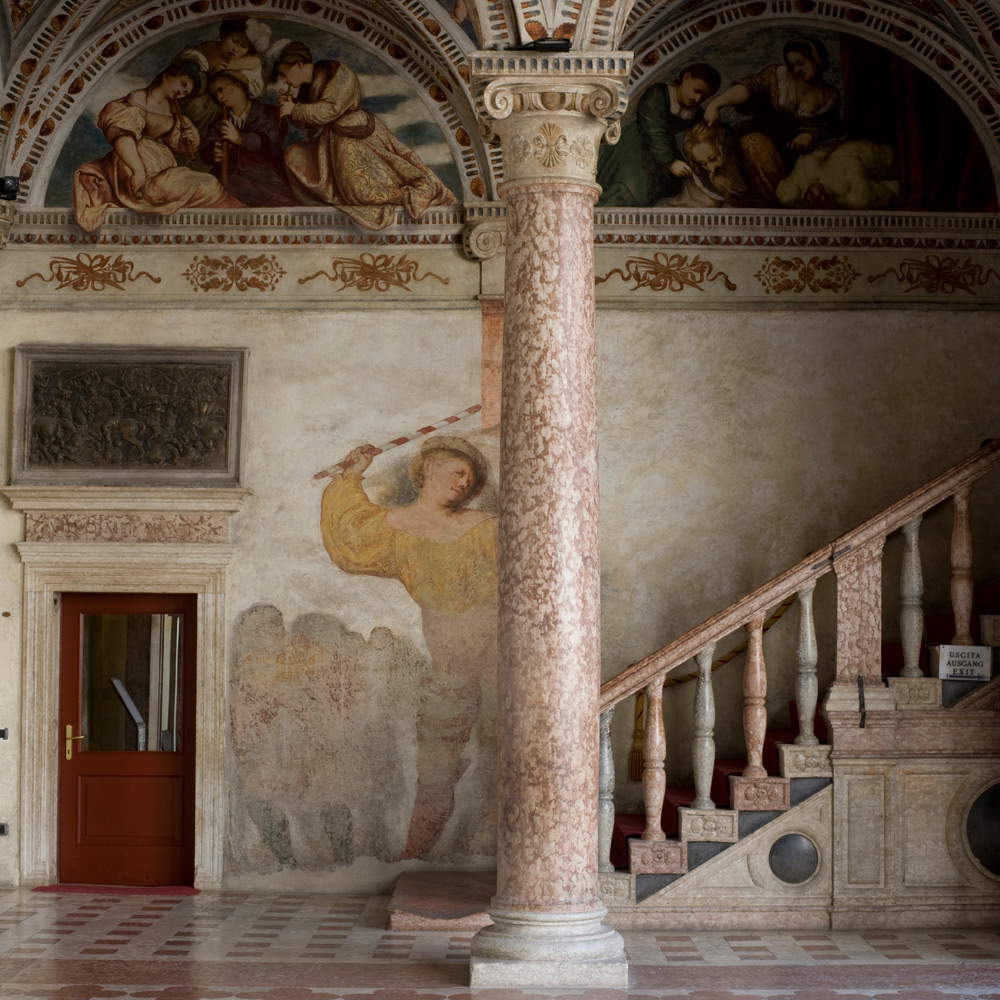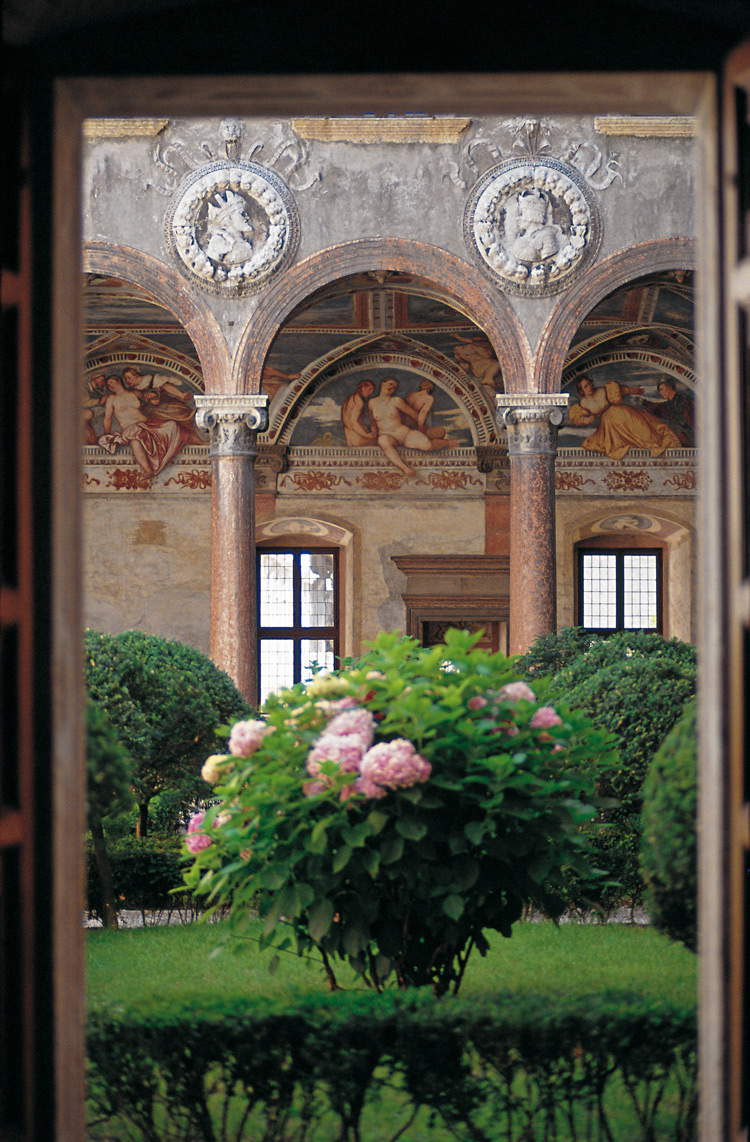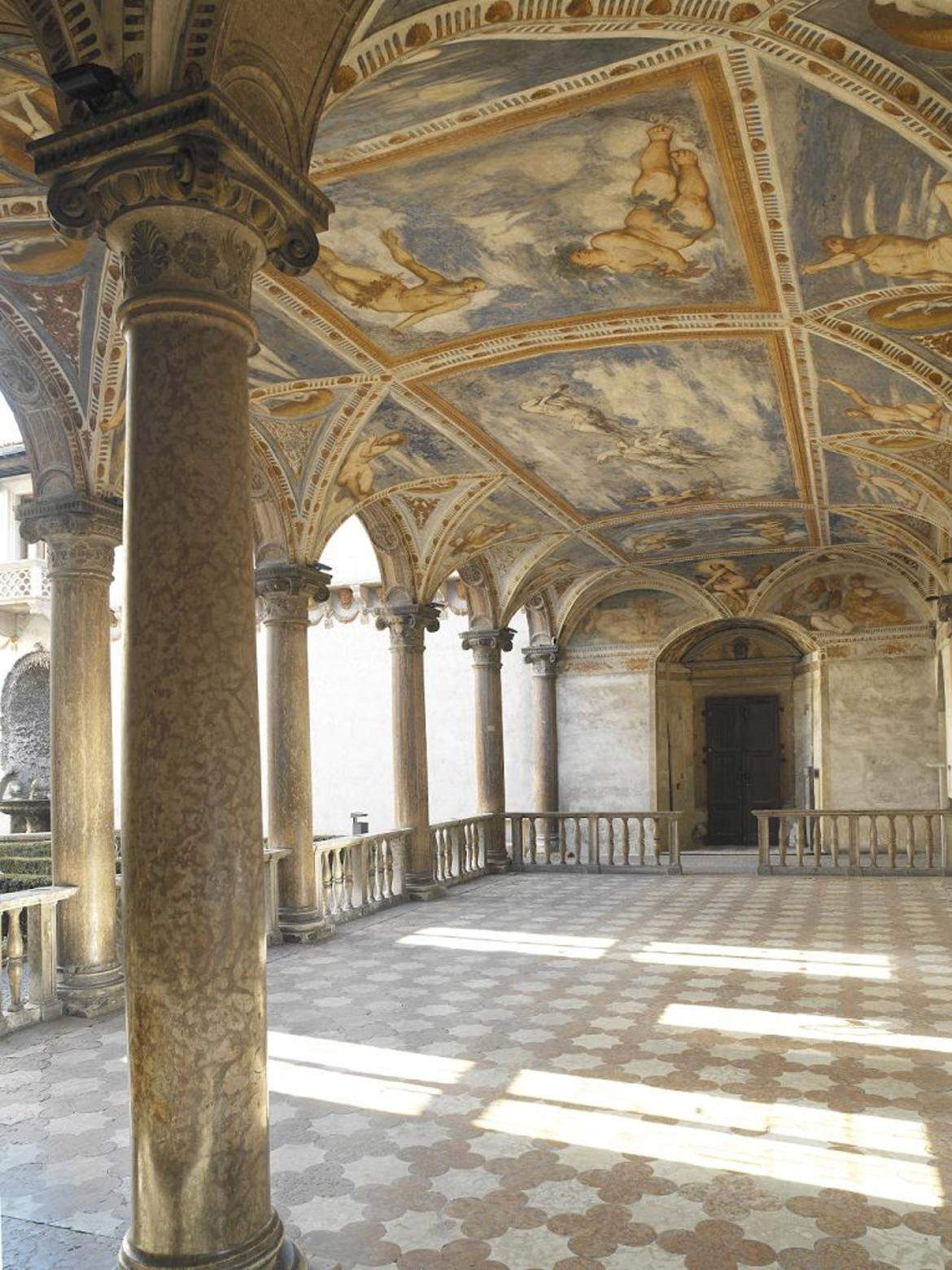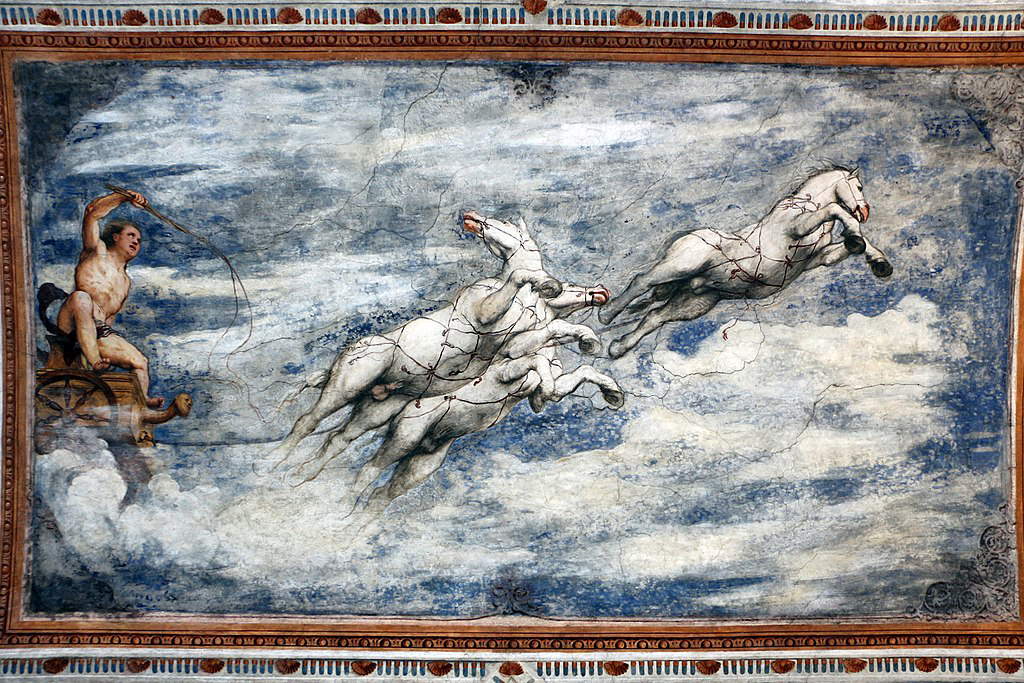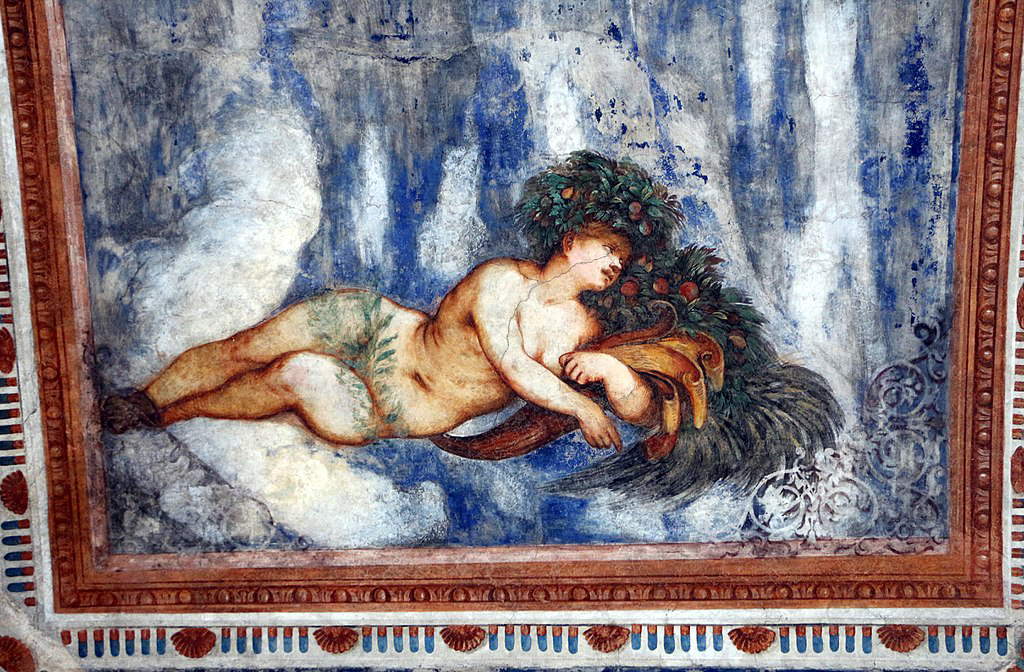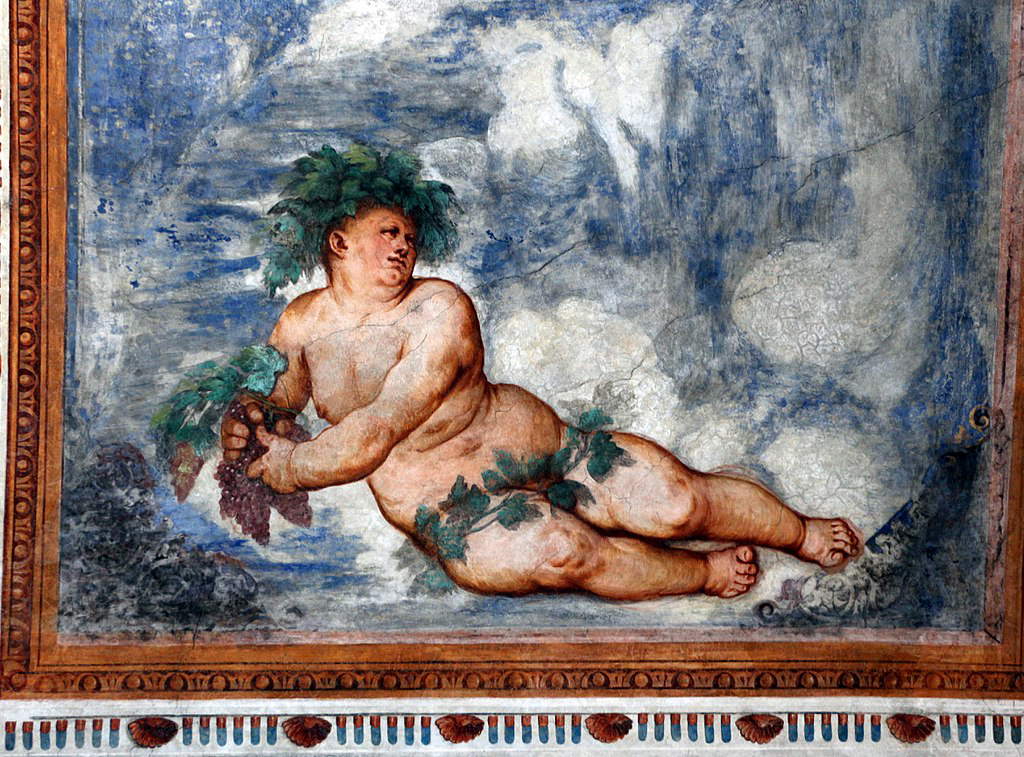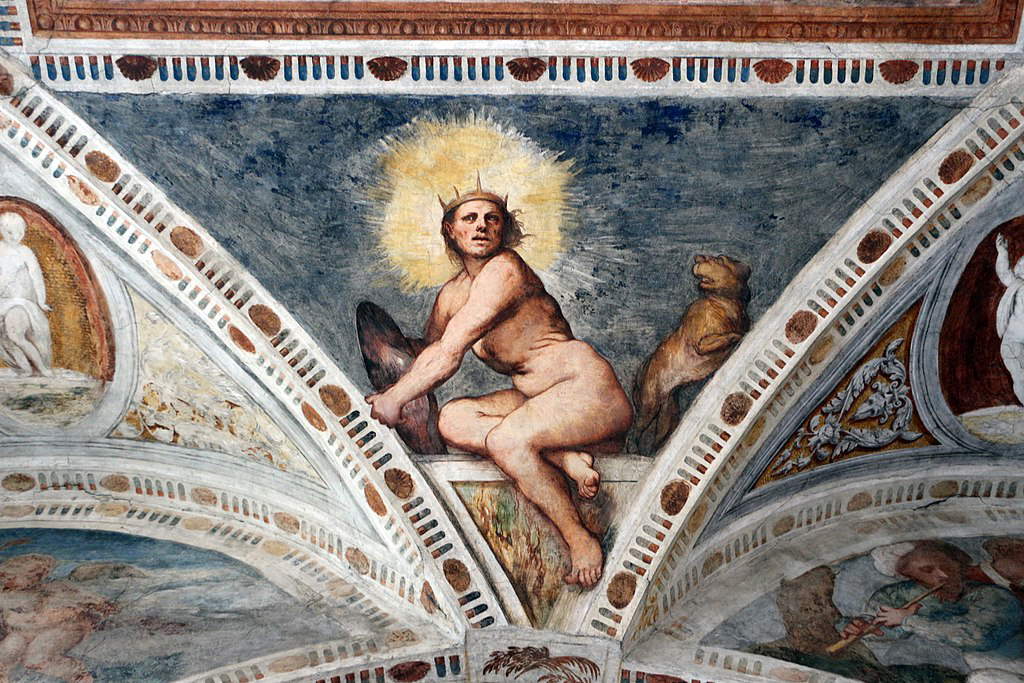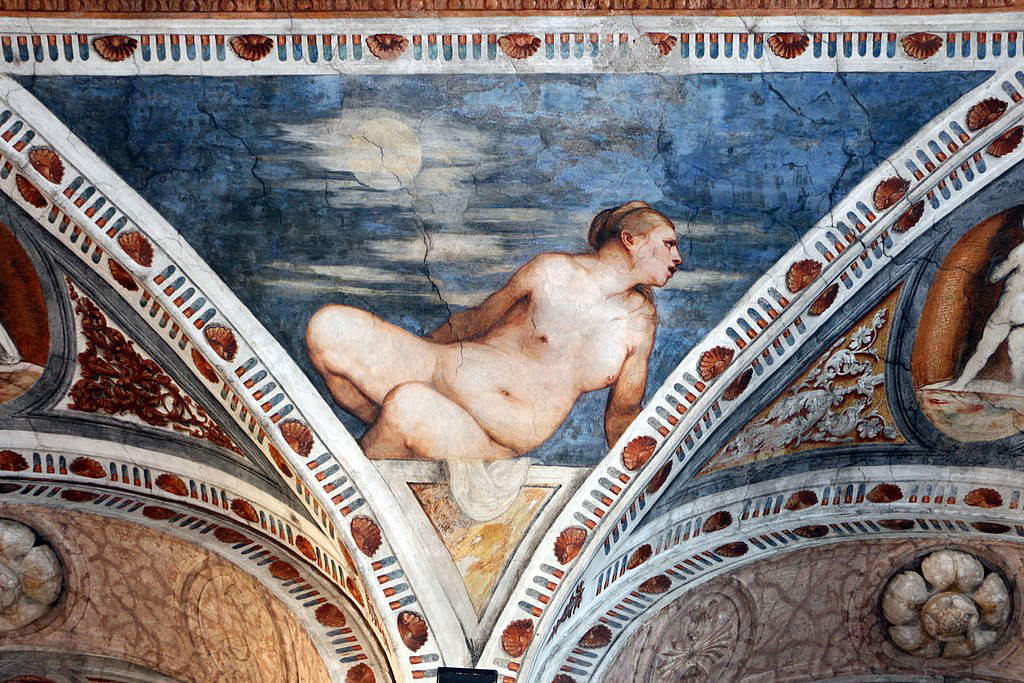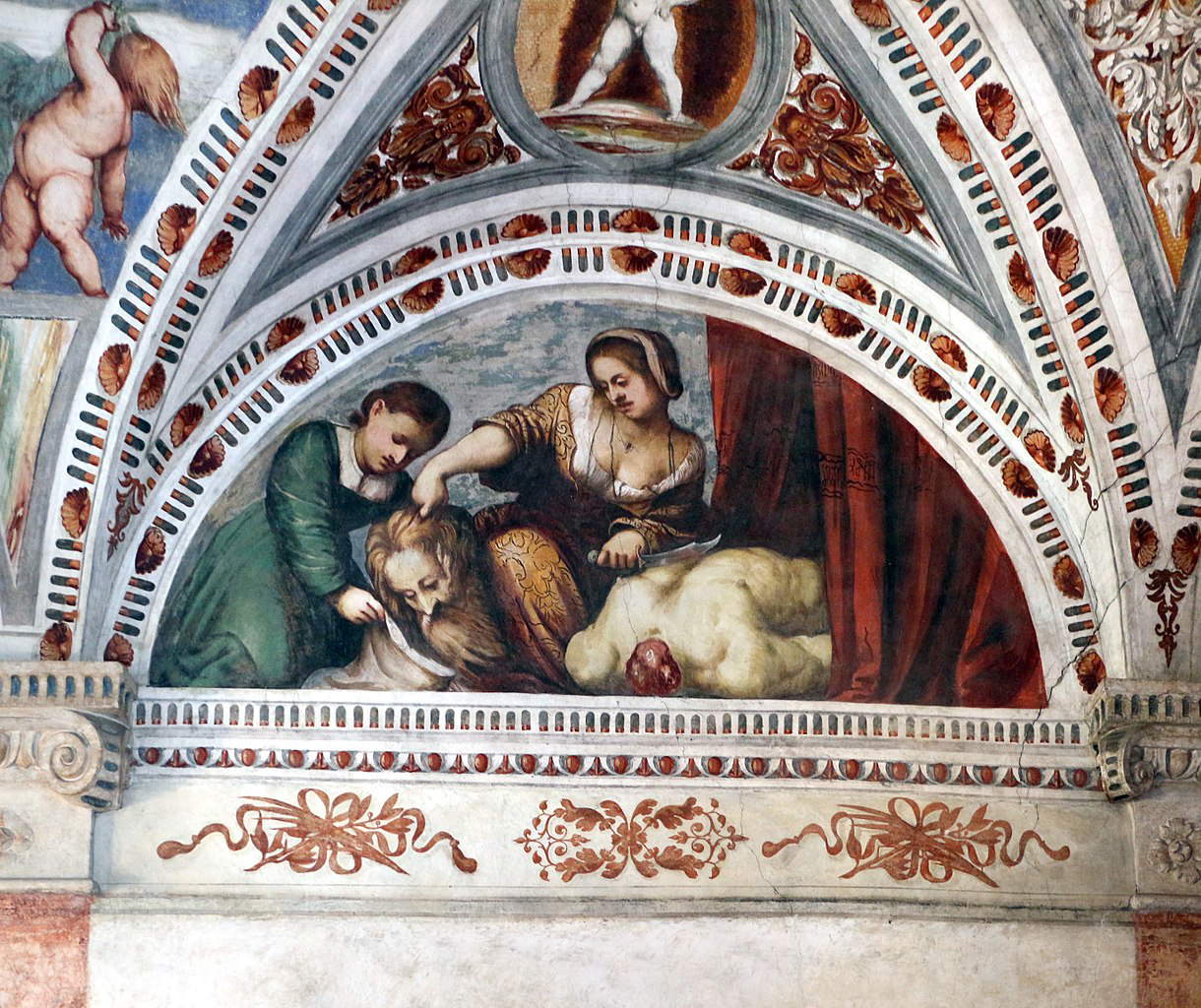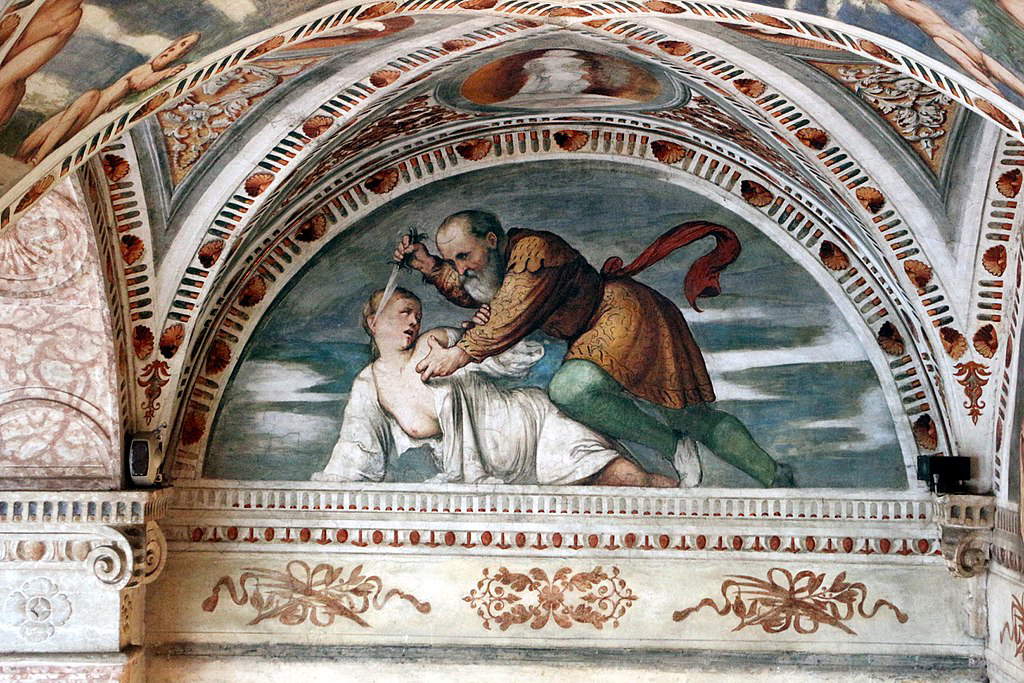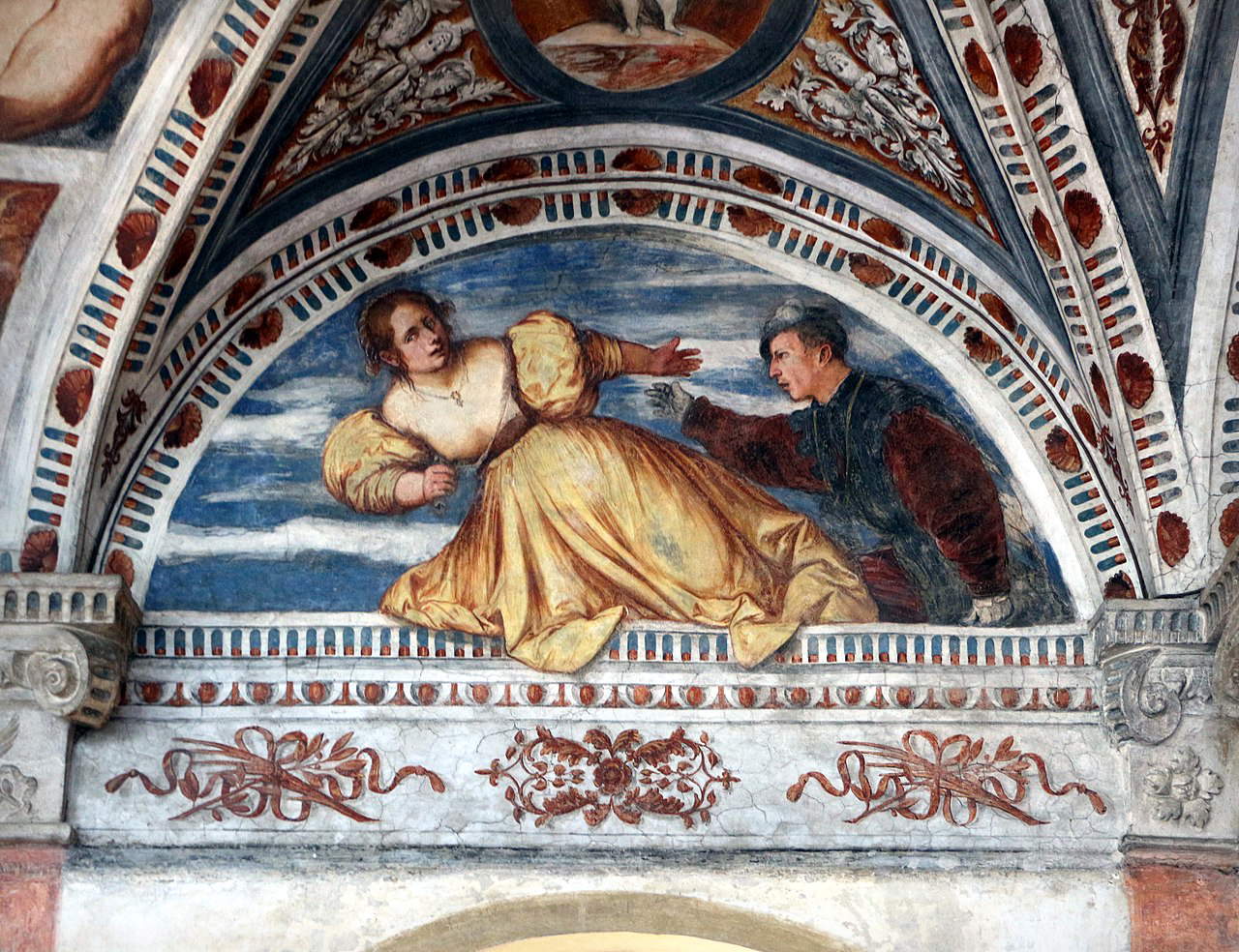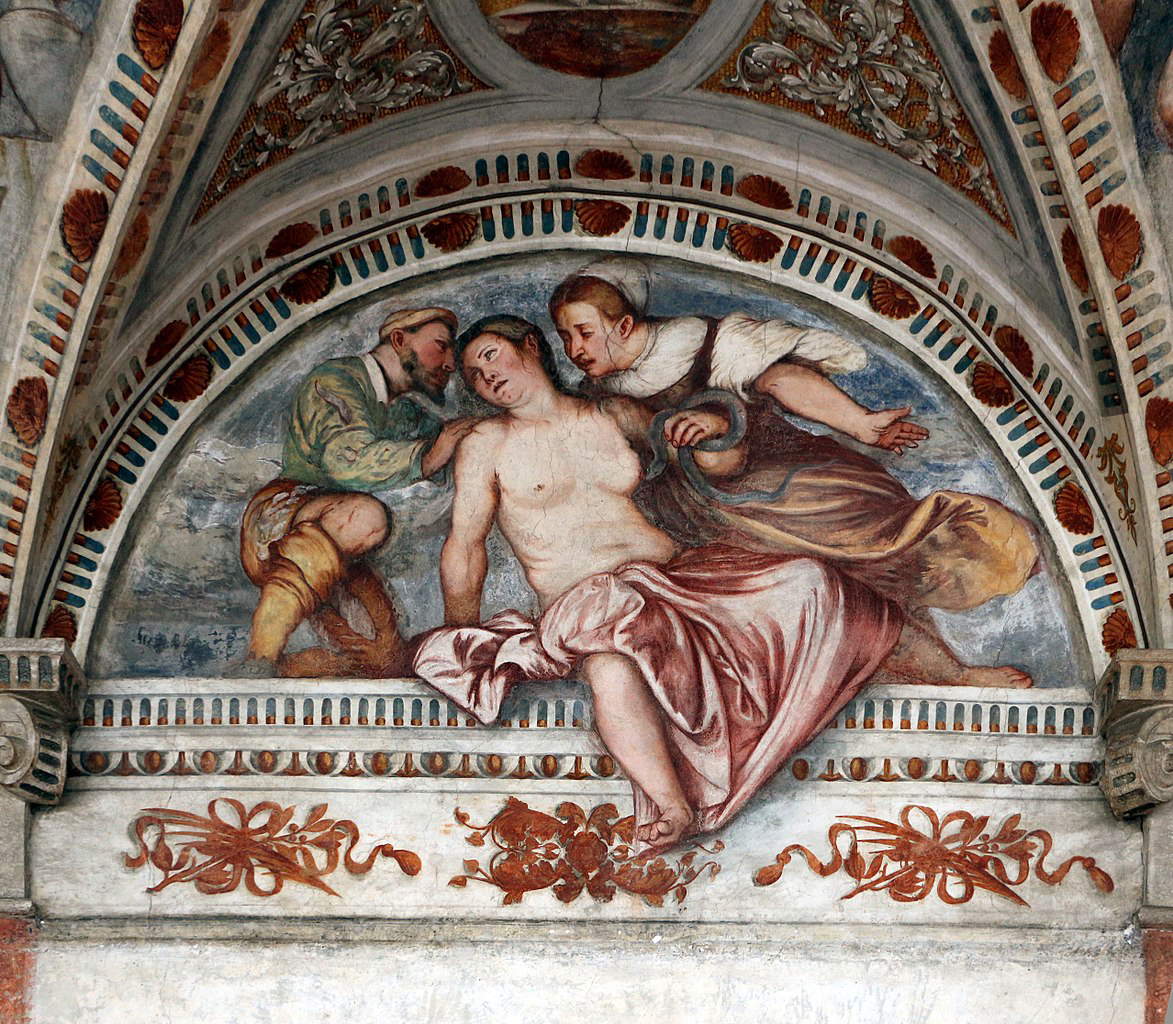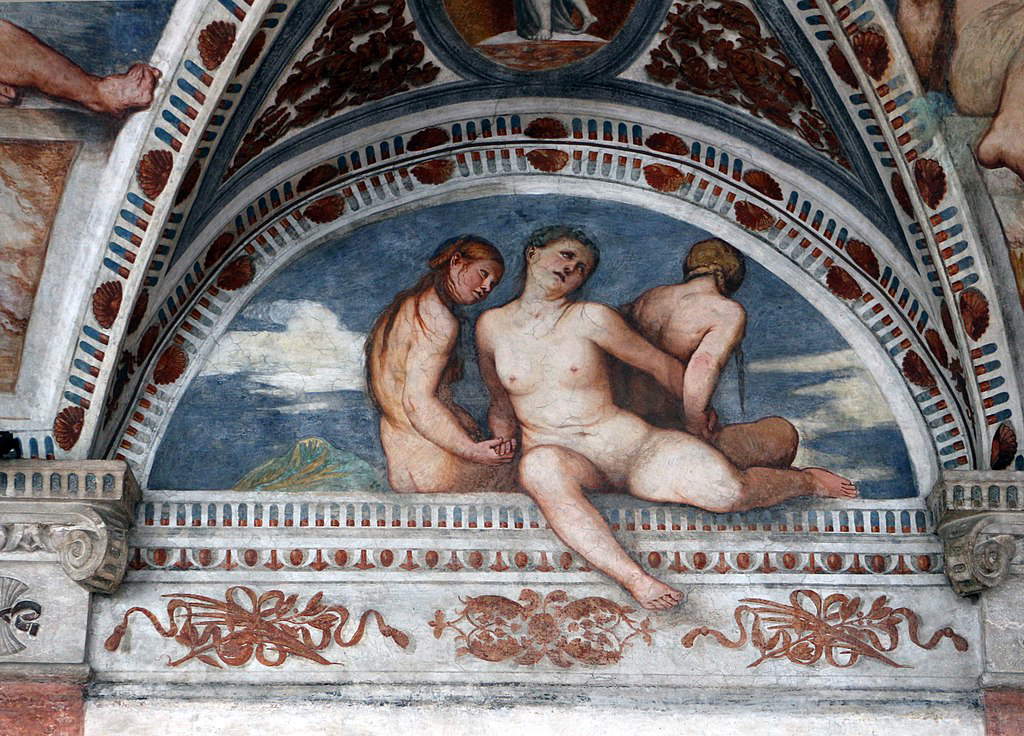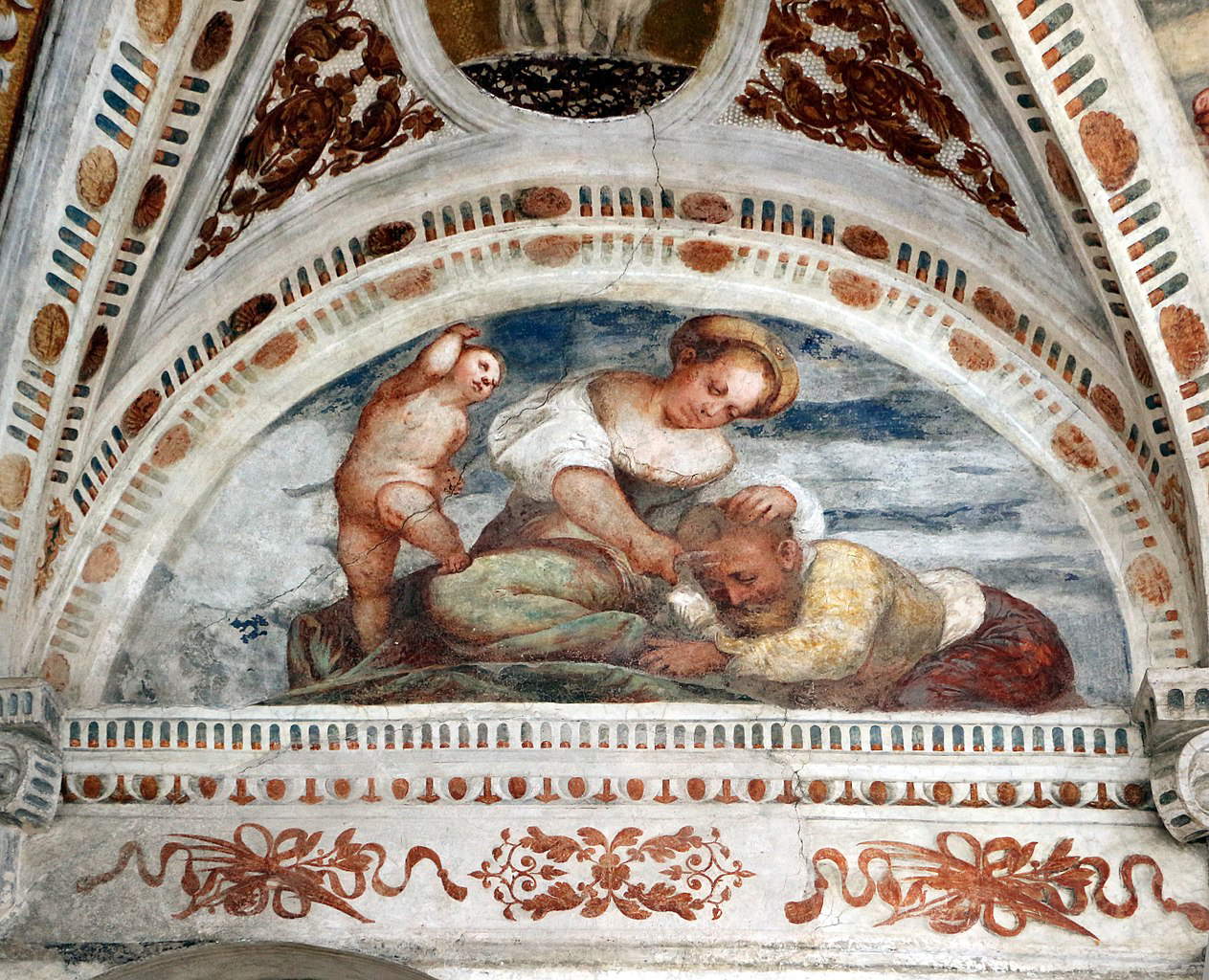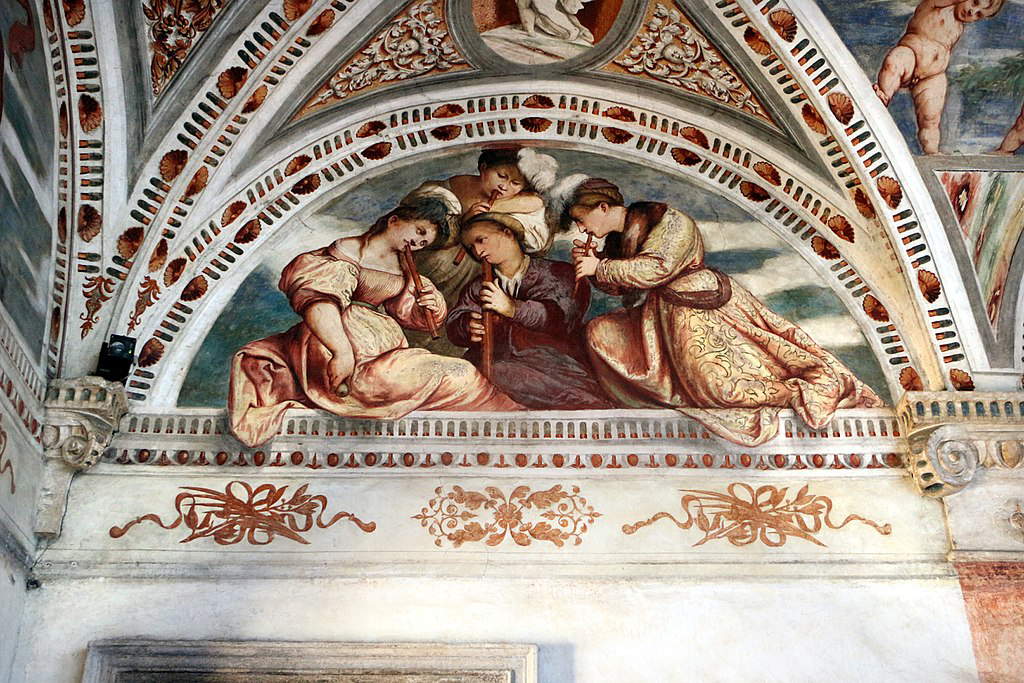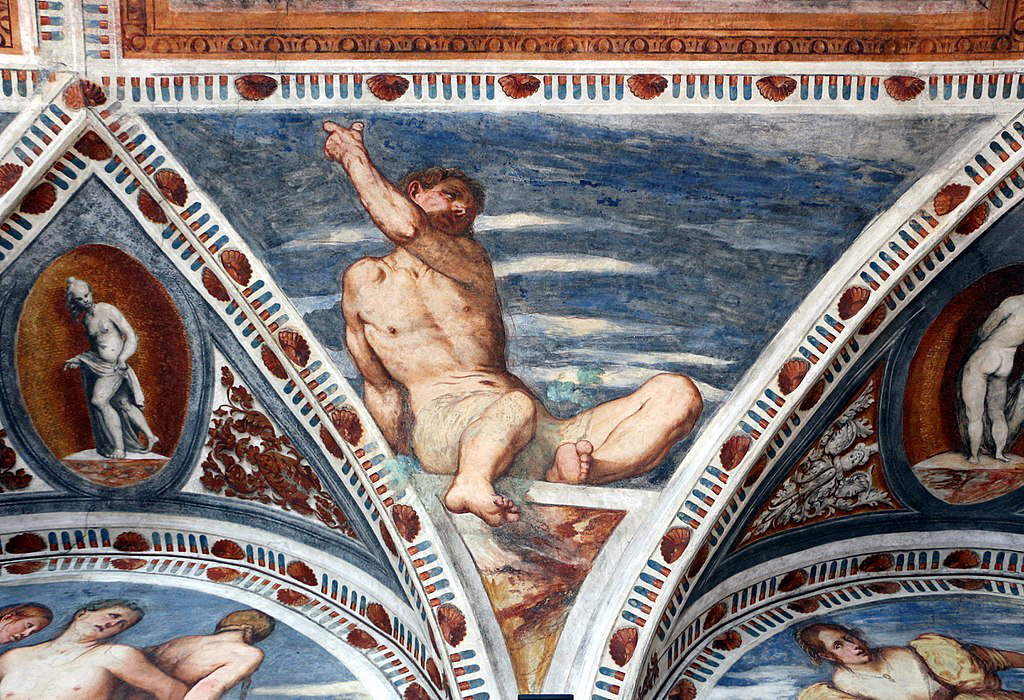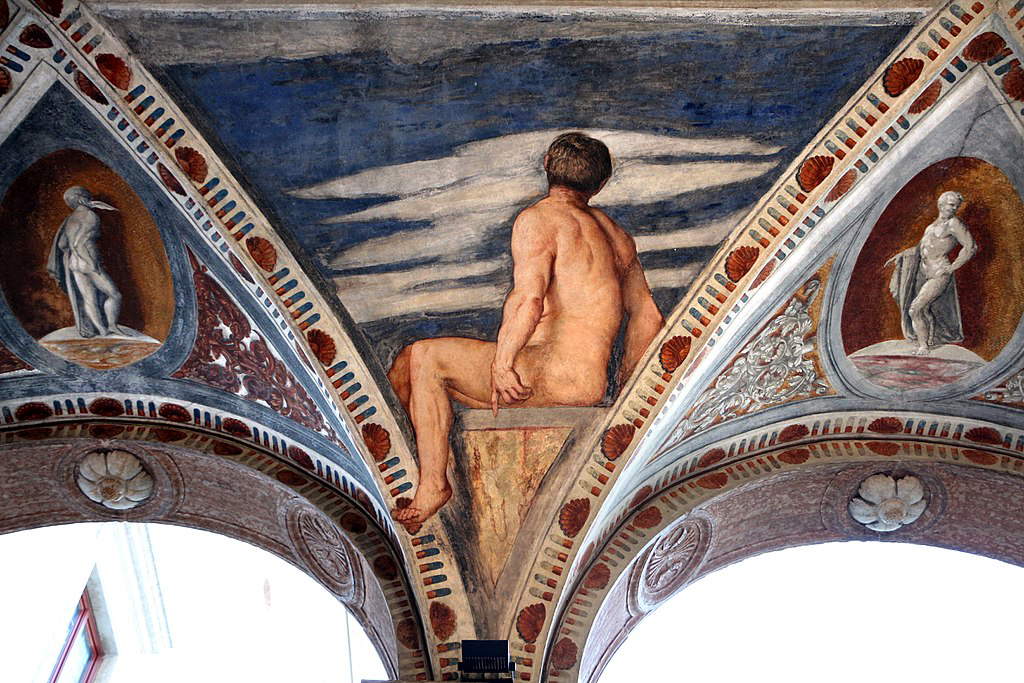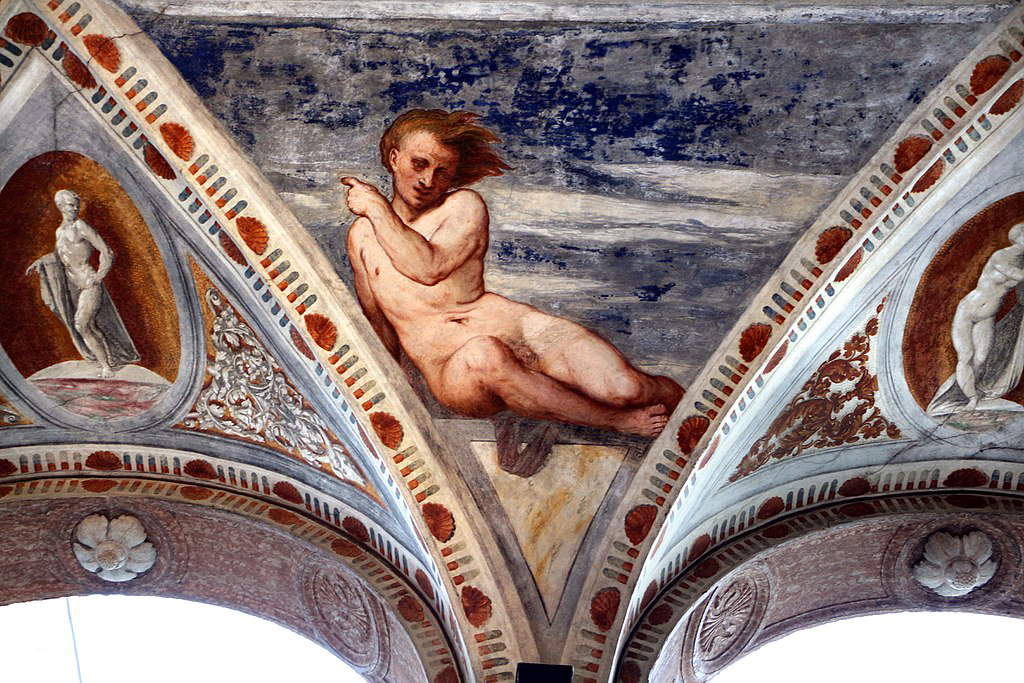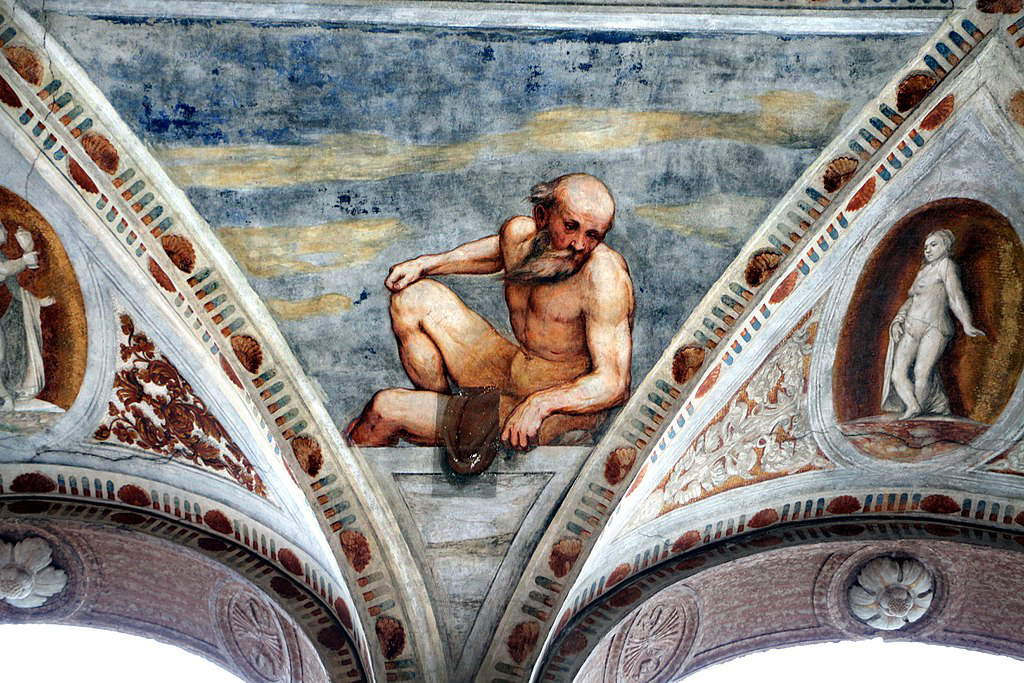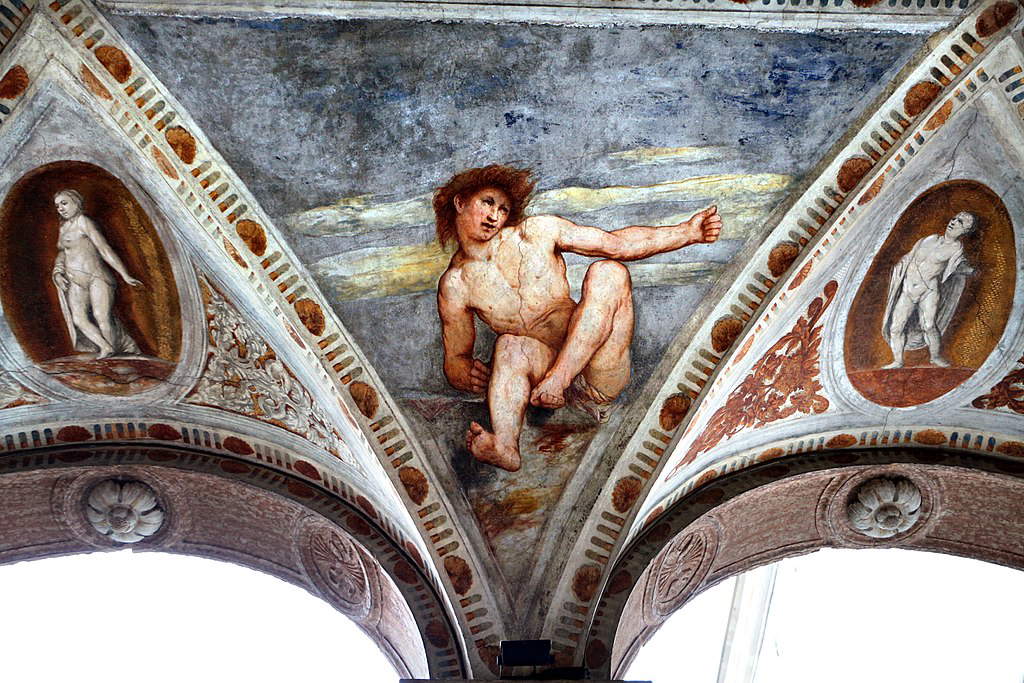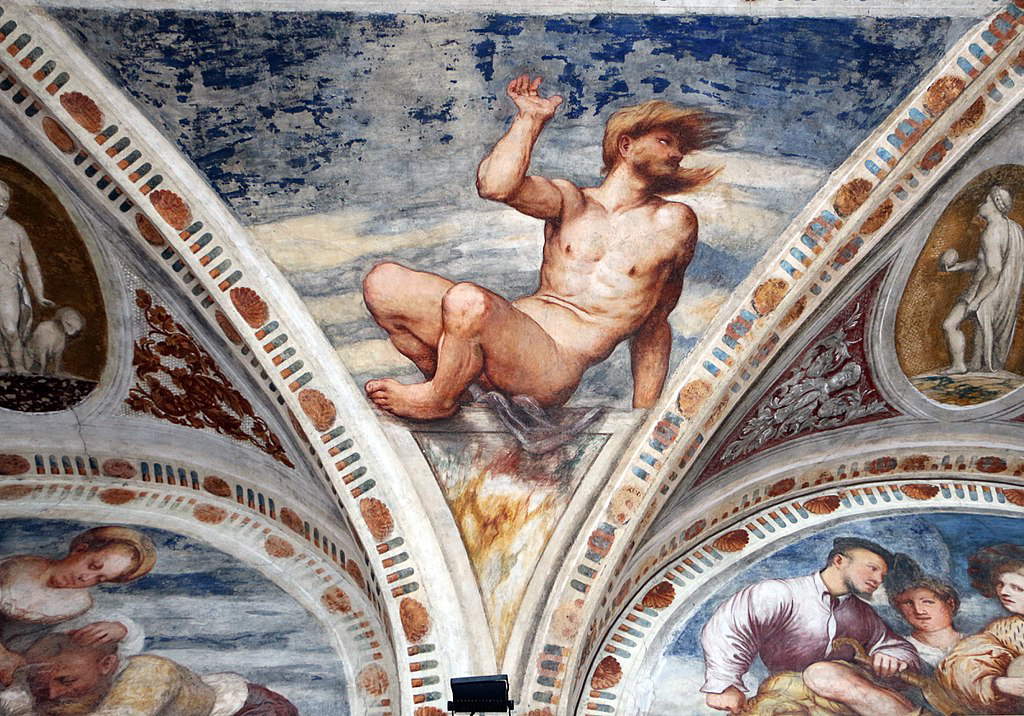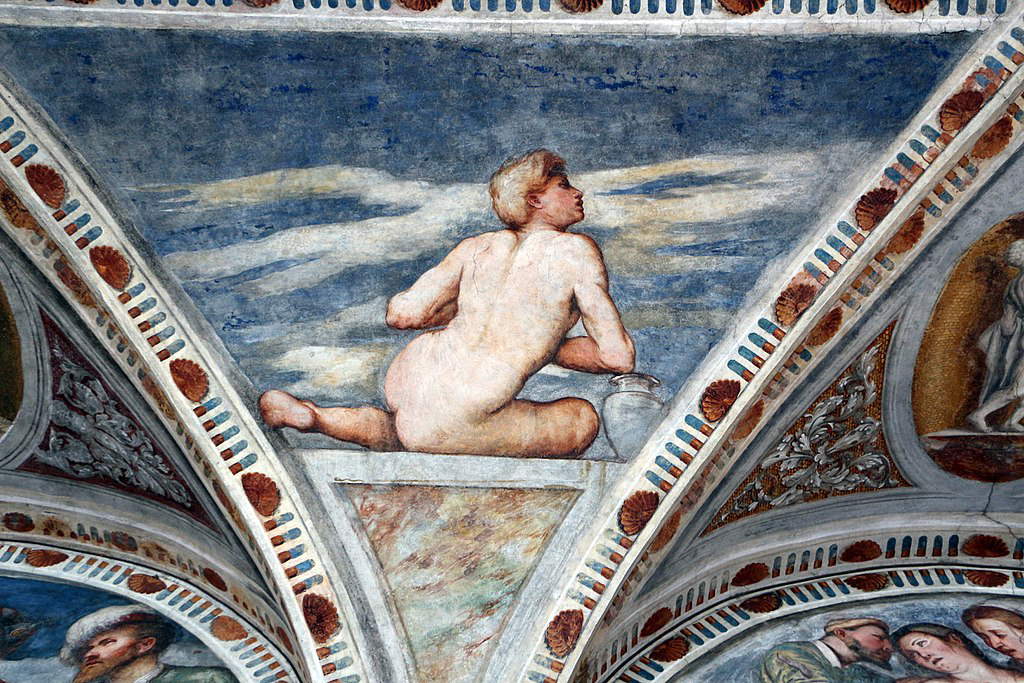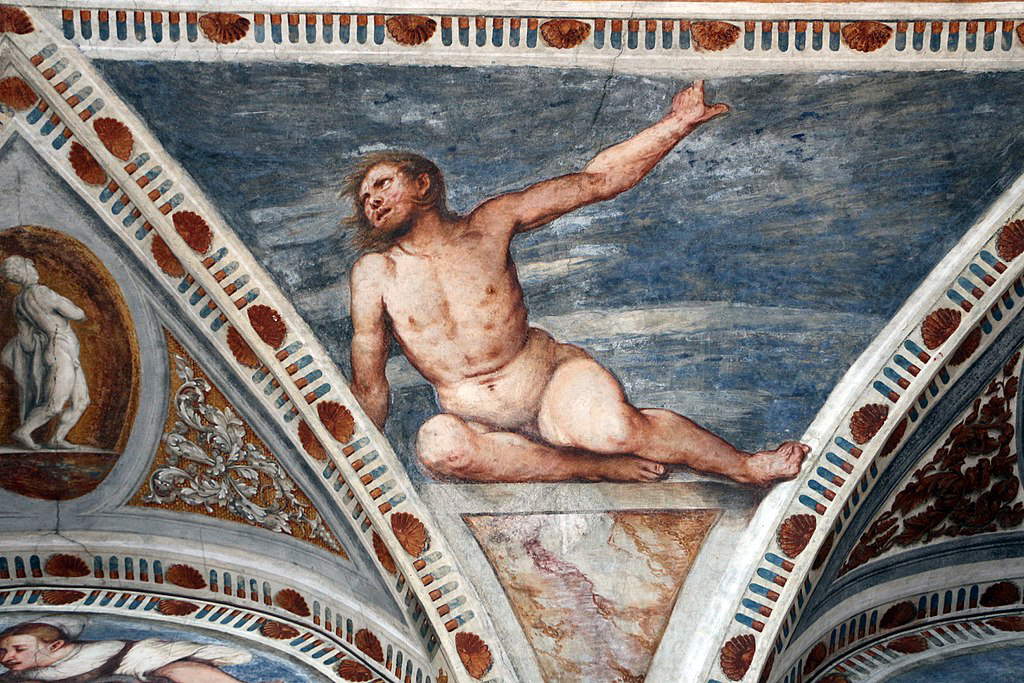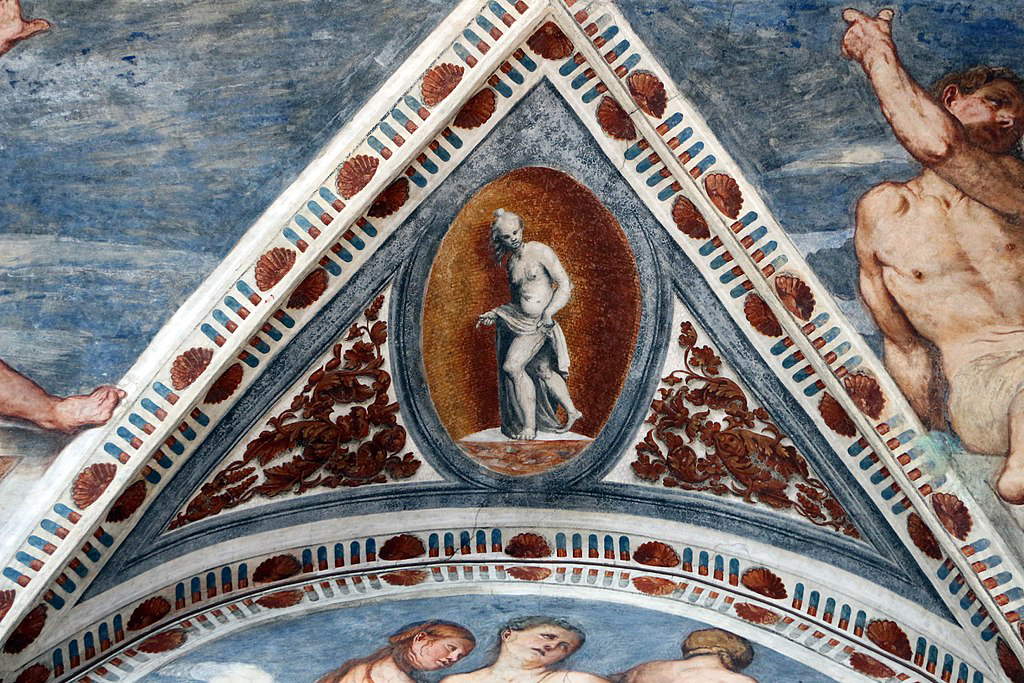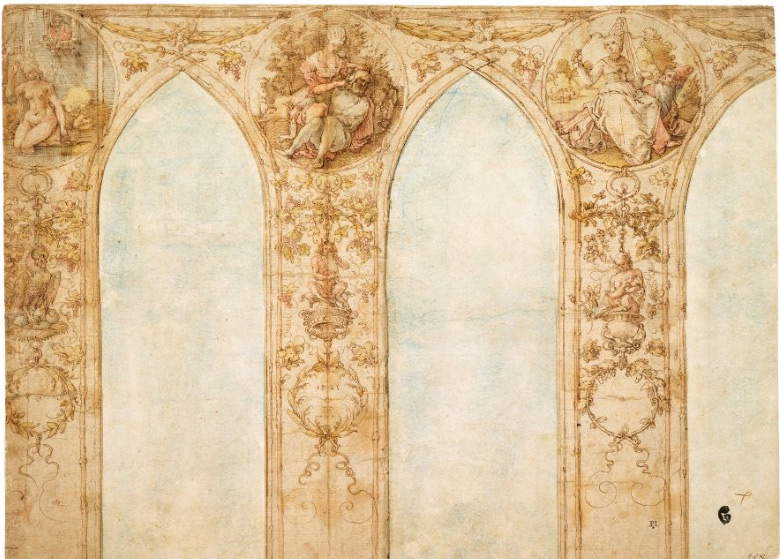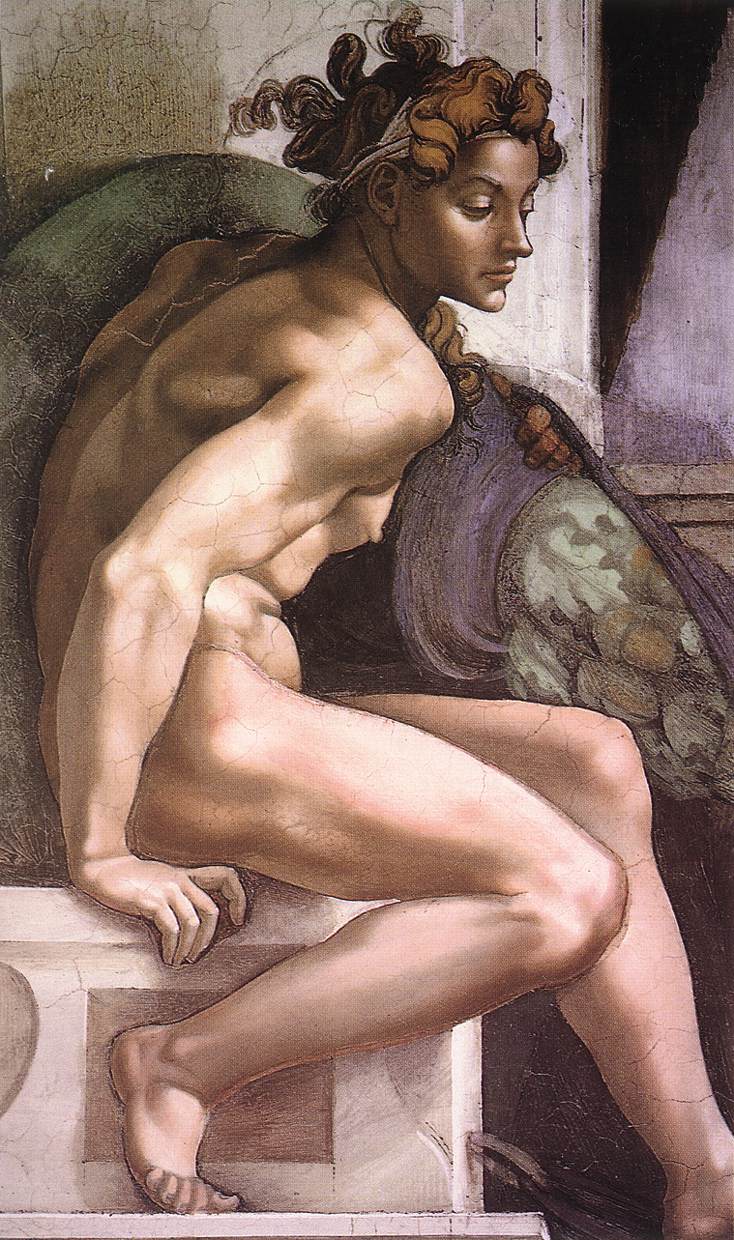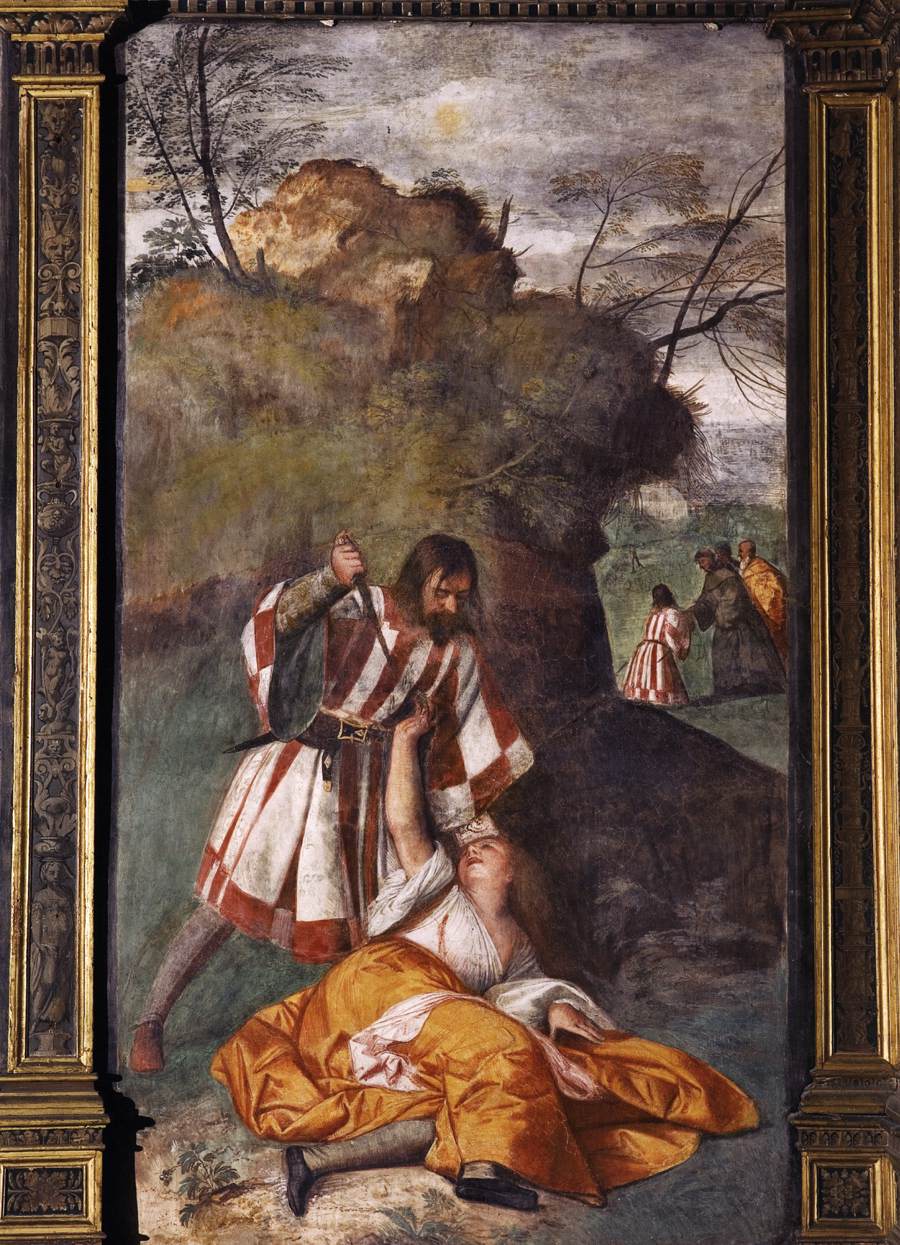by Federico Giannini, Ilaria Baratta , published on 14/03/2019
Categories: Works and artists
- Quaderni di viaggio / Disclaimer
The Loggia Grande of the Magno Palazzo in Buonconsiglio Castle in Trent was frescoed between 1531 and 1532 by Girolamo Romani, known as Romanino: it is one of the great masterpieces of the 16th century.
“A kind of vault of the Farnesina, as far as illustrative tasks and formal distribution are concerned”: this is how, in 1930, art historian Antonio Morassi defined the Loggia Grande of the Buonconsiglio Castle in Trento, one of the most sumptuous and magnificent frescoed rooms in the entire Trentino region. It was decorated between 1531 and 1532 by one of the greatest artists of the time, Girolamo Romani, known as Romanino (Brescia, 1485 - 1566). The city at that time was ruled by Bernardo Clesio (or Bernardo di Cles, Cles, 1485 - Bressanone, 1539), a leading member of a noble Trentino family and who became bishop of Trent in 1514: at that time, Trentino (which also included part of today’s province of Bolzano) was an autonomous state, dependent on the Holy Roman Empire and ruled by the prince-bishop, in a form of government that survived for eight centuries (from the 11th to the 19th). In the years immediately preceding the creation of Romanino’s masterpiece, Trentino was shaken by a revolution that started from the humblest strata of the population and was aimed, among others, at overthrowing the authority of the prince-bishop: gone down in history as Bauernkrieg, “peasants’ war,” the revolt, led by Michael Gaysmair, broke out in 1525, and yet Clesio managed to get the better of the insurgents in the space of just under four months. After stifling the sedition, the prince-bishop wanted to forcefully reassert his authority, and art was one of the tools with which Bernardo Clesio intended to achieve his goals. His political program included the construction of a real palace that would become the majestic residence of the prince-bishops: it was 1528 when work began on the Magno Palazzo, the 16th-century body of the Buonconsiglio Castle, built above the medieval walls and alongside Castelvecchio, the oldest nucleus. Clesio was a politician more akin to that of a Renaissance prince than a prelate: the renewal invested the whole city, which underwent a radical rearrangement (for example, the construction of buildings in stone rather than in wood, the traditional building material of the place, was promoted, and still new streets were opened, straight and perpendicular according to the principles of Renaissance town planning, the building of imposing palaces in the classical style was boosted), and the Magno Palazzo became the most obvious symbol of the new course imprinted by the prince-bishop.
By the end of the summer of 1531, construction work on the architectural structures of the Magno Palazzo was drawing to a close, so much so that Bernardo Clesio was able to begin calling the artists who would be responsible for the decorations. Aware that the building was to be both an instrument of power and an image of his own prestige and taste, Bernardo Clesio began a feverish activity as a true supervisor of the realization of the decorated parts of his mansion. He personally maintained relations with the artists and with the “superintendents” (i.e., superintendents) of the factories, when he could he went to the building sites to check on the progress of the work, he took care to converse not only with the painters but also with the stonemasons and masons so that everything would proceed on the right track, and when he could not be present because his numerous diplomatic and political engagements took him out of Trentino, he made himself heard through copious letters, so much so that one of the greatest art historians of the twentieth century, Enrico Castelnuovo, editor of a substantial study on the Castello del Buonconsiglio, described Clesio as “a very active commissioner by correspondence.” This study gave us a fascinating snapshot of the kind of relationship Clesio had with his painters. First and foremost, the bishop was obsessed with respecting the timelines of the works, as well as the budgets: in his missives he showed lively concern in case the works went slowly, he worked to seek solutions that might have accelerated them, he did not hide his anxiety if some unforeseen event occurred, and he constantly monitored expenses. Even the commission given to Romanino must have been based on savings: “circa quello excellente pittore bressano che si ha offerto venire,” he wrote in a letter sent to the above between June 26 and July 6, 1531, from České Budějovice in Bohemia, “si rimettemo a vui. Essendo bisogno, fareti quello medemo fatti cum li altri: et procurate siamo ben serviti cum mancho spesa si possa” (this is, moreover, a fundamental document for deriving information about the terminus post quem of Romanino’s presence in Trent).
Above all, however, Clesio discussed with the artists about the subjects of the works, worrying above all that they would be appropriate for a palace that was not only the prince’s residence, but also a diplomatic headquarters apt to receive foreign delegations. Thus, there was no room for subjects that the morals of the time deemed improper: in a letter in which reference is made to the intention of Dosso Dossi (Giovanni di Niccolò Luteri, San Giovanni del Dosso, 1474 - Ferrara, 1542), another great painter engaged in the undertaking, to decorate some rooms with scenes of the sack of Rome and the battle of Pavia (during which the French led by King Francis I were soundly defeated by the Empire), Clesio wrote that “nui siamo de parer contrario per dui rispetti, l’uno per esser opera di grande tempo e spesa, l’altro per esser cosa molto odiosa saltem per rispetto di Roma: et poderia accadere che ’l venisse [the pope], i sui legati, nuncii, oratori, [kings of France], et vedendo quelle loro figure, pareria le fusseno fatte in dispresio.” A distinctive feature of the iconographic program of the Magno Palazzo frescoes is their simplicity. Castelnuovo has remarked how Clesio was not interested in particularly erudite and complex themes: the prince-bishop was primarily concerned that the decorations be rich and, in keeping with the character’s thrifty nature, that they also be durable over time and not suffer from damage caused by weathering. And yet Clesio, who was yes trying to maximize the resources at his disposal but was nonetheless caught up in the desire to build himself a sumptuous residence, also cared that there was gold everywhere, and sometimes even when the work was finished, the prince-bishop made arrangements for the decorations to be enriched with additional gilding. The richer and more lavish the frescoes were, the better they met the taste of the patron. This is also evident from his letters, such as the one sent in September 1531 to Andrea Crivello above, in which he writes: “as for the friso of the great hall, insieme cum li altri tu disponerai sì como ne hai scritto, over cum qualche meglio modo che si potrà excogitar. Et considerando la belleza, grandezza et altri adornmenti di essa sala, tu poi immaginarti di quale sorte deve essere questo friso, con ciò che sia molto desidereremo che ’l sia vago, grande, riccho di oro et che corrisponda al resto de la sala”.
Another singular aspect of his program was the lack of intermediaries between patrons and artists: that is, as far as we know, at the Castello del Buonconsiglio there was no scholar, humanist or erudite to elaborate the subjects of the paintings, as was the case almost everywhere else in Italy. In the Magno Palazzo, the discussion of the subjects of the frescoes involved only the prince, the artists and the superintendents: Clesio granted, moreover, a certain freedom of choice to the artists, subject, as we have seen, to his provisions on the decency of the scenes, and taking into account the fact that, in any case, the wall figurations had to have his explicit permission. When, for example, Andrea Crivello presented him with Dosso’s designs for the decorations of the “Stua granda” (no longer extant today), Clesio expressed his disapproval on the grounds that these designs (they were episodes from the Old Testament) seemed to him “more soon to be a thing of giesia than to be fitting for such a place,” that is, they seemed more suitable for a church than for a palace, and he therefore suggested adding “qualche fabula de Ovidio over de altra, secondo che vi paresse esser più al proposito.” The commissioner, however, except for rare exceptions, never provided precise indications on the subjects to be painted, but merely gave rather rough ideas. For example, in a letter dated July 1, 1533, the subject of which is the decorations of the garden loggia, we read that “as for the depenture de la logia in the garden, havemo iudicato esser meglio che si facia le figure conforme al loco, come sono verdure, caccie et simile cose et cossì exequirete.” And given the lack of precise indications, it also results in the lack of a true overall iconographic program for the entire Magno Palazzo, or even just part of it. The one in Trent is thus a rather rare case, with the result that the harmony between the rooms is directly proportional to the experience and culture of the individual artists: the scholar Thomas Frangenberg, in one of his studies devoted precisely to the decoration of the Magno Palazzo, pointed out that the rooms frescoed by Dosso Dossi and his brother Battista (San Giovanni del Dosso, 1517 - Ferrara, 1548) tend to have greater intellectual coherence than those entrusted to Romanino (Dosso, after all, compared to the younger Romanino boasted long experience at the court of Ferrara, while the Brescian at that date had worked only for ecclesiastical patrons, and the undertaking of the Loggia was the most culturally demanding one that had ever happened to him).
 |
| Romanino, Frescoes of the Great Loggia of the Magno Palazzo (1531-1532; frescoes; Trento, Castello del Buonconsiglio). Ph. Credit D. Lira |
 |
| Romanino’s Loggia, detail. Ph. Credit P. Marlow |
 |
| Romanino’s Loggia, detail. Ph. Credit G. Carfagna |
 |
| Romanino’s Loggia, detail. Ph. Credit R. Bragotto |
 |
| Romanino’s Loggia, detail |
The shortcomings in consistency also apply to Romanino’s masterpiece, the magnificent Loggia entirely frescoed by him. There is, in other words, no unified thread that binds all the compositions that the artist frescoed in the magnificent environment: we see scenes taken from the repertoire of classicism and from biblical episodes that could refer to the virtues of women, but to these are also added mythological subjects and other allegories whose relationship with the rest of the figurations of the Loggia does not appear entirely clear. The first to provide a description of the frescoes in this transitional room, which serves as a link between two different parts of the Magno Palazzo, was the Sienese physician Pietro Andrea Mattioli (Siena, 1501 - Trent, 1578), who in 1539 published in Venice a poem in octava rima whose subject is easily guessed from the title: The Magno Palazzo of the Cardinal of Trent (it should be specified that, in 1530, Clesio was created cardinal by Pope Clement VII). Mattioli settled in Trent in 1527 and obtained the title of court physician: his profession, however, did not prevent him from also trying his hand at letters. His poem had little luck, but today it is a valuable source for reconstructing the events of the Magno Palazzo in its early years (also because it is the first and most detailed description of the building published in the entire sixteenth century). The Loggia is presented to the reader in these verses: “Above columns of the hardest stone / Of a thousand carvings fabricated, and girded, / In vaulted turns a most dignified loggia, / With its circumstances well distinguished, / And if it is not of the widest breadth, / The beautiful histories, which here are pinned, / And much ornamented with colors and gold, / Make it assemble to a celestial choir.” This is followed by a description of the frescoes, presented in the order in which they follow one another, with the sole exception of the three concert scenes, all of which are enumerated last. The frescoes decorate the vault and the lunettes that are arranged along the five arches and on the opposite side: beginning with the part closest to the stairs, we find in order the biblical heroine Judith beheading the Assyrian general Holofernes, a concert, the murder of Virginia by her father Virginius (an episode from ancient history: the father killed his daughter to save her from a hateful violence that the decemvirs Appius Claudius was about to perform on her), the suicide of Lucretia (the Roman beauty who killed herself following the rape she suffered from Tarquin, son of King Tarquin the Superb), the three Graces, the death of Cleopatra, a further concert, Delilah cutting Samson’s hair (as is well known, the biblical hero had revealed to the woman he loved that the secret of his strength lay precisely in his hair, which if cut caused him to lose his prodigious vigor), a third concerto, and finally the scene with Cupid and Psyche, the fable narrated by Apuleius. In the center of the vault, however, we find the fresco depicting the Fall of Phaeton, surrounded by allegories of the four seasons. Also decorated is the vault of the room near the staircase leading to the upper floor, with the episode of the Rape of Ganymede. Finally, the pendentives are decorated with allegories of the sun and moon and eight nudes (seven male and one female only). Other smaller nudes, painted in monochrome, occupy the medallions placed in the veils instead.
It is difficult to establish the overall meaning of the work given the heterogeneity of the scenes depicted: however, there are those who have tried to do so. Among them is art historian Alessandro Nova, an expert on Romanino’s art, who has tried to explain the depictions on the vault in relation to the fact that the room overlooks an exterior and therefore witnesses the changing of the seasons and the alternation of day and night. In short, to use Nova’s words, such figurations “lend themselves well to the decoration of a loggia that the artist imagined open to the sky.” As for the scenes in the lunettes, on the other hand, Nova finds a common thread in the fact that they would all refer to the theme of love pains, and would therefore have been “suited to the function of the room intended to host pleasant dances accompanied by concerts similar to those depicted by Romanino in the other lunettes of the same loggia.” In any case, an interpretation such as the one proposed by Nova (moreover the basis for a more recent interpretation, which instead presupposes the existence of a precise message, and which will be discussed below), would not be incompatible with Bernardo Clesio’s “line”: that is, they would be themes simply suited to the type of environment, but in any case lacking an elaborate iconographic program or defined in individual details. However, the scholar also pointed out that the decision to decorate an architectural environment (perhaps precisely a loggia) with stories of classical or biblical heroines had a precedent, a drawing by Albrecht Dürer (Nuremberg, 1471 - 1528) dating from 1521.
As for the ten naked men, an interesting consideration by Mattioli focuses around these very particular figures, who writes as follows in his poem: “Around around the noble floors / Mostrat’hal buon pittor l’arte qual sia / Di finger corpi in vivi gesti, / Se ben dice qualchun non sono honesti. / L’arte del buon pittor degna si vede / Nel saper ben formare un corpo ignudo. / Non fa dell’eccellenza vera fede / Il vestirr chi di skirt, e chi di scudo. / Now if I tread on someone’s foot / Let him be silent, for I conclude the truth of art. / It’s easy to accommodate some graceful head over a beautiful robe. / S’honesta ben non pareve la pittura, / Come si richiedeva al luogo degno, / Lo fe il pittor per mostrar che natura / Ben sapeva imitar con suo disegno. / Ma perche d’honestà poi ha cura / Il tutto ritrattò con grand ingegno, / E dimostrò col divinello / Fare, e disfar saa qualcosa anche ello”. The physician-poet starts from an observation: the true artist is the one who is able to correctly paint a nude body, because it is much more difficult to depict the anatomies of a human body than a beautiful robe to which a head can be added, and consequently it is by his skill in the genre of the nude that his quality and talent are measured. However, Mattioli continues, the nude clashes with the necessities of “honesty,” or decorum: his poem therefore includes a theoretical formulation of the problem of compatibility between the nude and the impositions of the rules of decency. The author thus intervenes with some verses (“Il tutto ritrattò con grand ingegno, / E dimostrò col divin pennello / Fare, e disfar sapea qualcosa anch’ello”) that are not easy to interpret. It seems clear that between the reasons for the nude and those for the decoration, Mattioli is leaning toward the latter, but it is more foggy to understand how Romanino would have behaved toward his figures, since the poet writes that the artist knew how to “do and undo.” Indeed, the ten nudes, at some point in history, were covered up (somewhat as had happened to the Sistine Chapel nudes), and the additions were removed only recently, with the 1985-1986 restorations. Some have interpreted Mattioli’s lines as suggesting that Romanino himself had been involved in the process of covering the naked limbs, but the poor quality of the overlapping robes makes the hypothesis that it was the Brescian painter who painted them entirely unlikely (the 1980s restoration report assumed that the additions dated from the eighteenth century). Nova suggested that, although the repainting removed in the 1980s was much later, Romanino may also have intervened with additions made in the dry. Alternatively, again according to Nova, Mattioli could be referring only to the figures of the four seasons, whose genitals were actually covered by Romanino himself. According to Frangenberg, on the other hand, it is more likely that Mattioli was referring to the process of artistic creation in general terms than to a concrete case, not least because he himself provides a justification for the nudes (which have no symbolic meaning: they serve only to demonstrate the artist’s skills of mímesis ): it is possible that the Sienese doctor intended to compare the painter’s ingenuity to that of nature, since both are endowed with the power to “make and unmake” (and in this case, probably the “unmake” referred to Romanino is to be understood as his ability to paint even clothed figures should the laws of decorum have required it).
 |
| Romanino’s Loggia, detail: the fall of Phaeton. Ph. Credit Francesco Bini |
 |
| Romanino’s Loggia, detail: allegory of Spring. Ph. Credit Francesco Bini |
 |
| Romanino’s Loggia, detail: allegory of Summer. Ph. Credit Francesco Bini |
 |
| Romanino’s Loggia, detail: allegory of Autumn. Ph. Credit Francesco Bini |
 |
| Romanino’s Loggia, detail: allegory of Winter. Ph. Credit Francesco Bini |
 |
| Romanino’s Loggia, detail: allegory of the Sun. Ph. Credit Francesco Bini |
 |
| Romanino’s Loggia, detail: allegory of the Moon. Ph. Credit Francesco Bini |
 |
| Romanino’s Loggia, detail: Judith and Holofernes. Ph. Credit Francesco Bini |
 |
| Romanino’s Loggia, detail: murder of Virginia. Ph. Credit Francesco Bini |
 |
| Loggia del Romanino, detail: suicide of Lucretia. Ph. Credit Francesco Bini |
 |
| Romanino’s Loggia, detail: suicide of Cleopatra. Ph. Credit Francesco Bini |
 |
| Romanino’s Loggia, detail: the three Graces. Ph. Credit Francesco Bini |
 |
| Romanino’s Loggia, detail: Samson and Delilah. Ph. Credit Francesco Bini |
 |
| Romanino’s Loggia, detail: Amore e Psiche (or Venus and Cupid). Ph. Credit Francesco Bini |
 |
| Loggia del Romanino, detail: Concert. Ph. Credit Francesco Bini |
 |
| Loggia del Romanino, detail: Concert. Ph. Credit Francesco Bini |
 |
| Loggia del Romanino, detail: Concert. Ph. Credit Francesco Bini |
 |
| Romanino’s Loggia, detail: nude. Ph. Credit Francesco Bini |
 |
| Romanino’s Loggia, detail: nude. Ph. Credit Francesco Bini |
 |
| Romanino’s Loggia, detail: nude. Ph. Credit Francesco Bini |
 |
| Romanino’s Loggia, detail: nude. Ph. Credit Francesco Bini |
 |
| Romanino’s Loggia, detail: nude. Ph. Credit Francesco Bini |
 |
| Romanino’s Loggia, detail: nude. Ph. Credit Francesco Bini |
 |
| Romanino’s Loggia, detail: nude. Ph. Credit Francesco Bini |
 |
| Romanino’s Loggia, detail: nude. Ph. Credit Francesco Bini |
 |
| Romanino’s Loggia, detail: monochrome nude. Ph. Credit Francesco Bini |
The reading of the frescoes can begin with the episode of the Fall of Phaeton, the mythological son of the god Helios who, after having insisted to his father that he could drive the chariot of the Sun, because of his inexperience with the vehicle fell ruinously to the ground (an episode that, in the context of a prince’s residence, can take on a political significance, as an invitation to govern wisely and without making rash decisions). The artist depicts Phaeton driving his chariot against the backdrop of a blue sky furrowed with clouds: here Romanino demonstrates his talent in the field of perspective rendering by proposing the horses in a daring foreshortening from below, making them float in the air (and to see something similar again would take about ninety years: the most worthy successors of the Brescian painter’s horses are those frescoed in 1621 by Guercino at the Casino dell’Aurora in Rome) and placing them within an oblique pattern that gives further movement to the scene. The blue backgrounds are the basis of all the scenes in the cycle of the Loggia Grande, and on them stand out the figures to which Romanino gives almost plastic prominence, accentuated by the light emanating from the blue backgrounds and the consequent contrast with the shadows made with earthy colors, also capable of infusing vividness into the characters painted on the Loggia, despite the reduced chromatic range used by the artist: “only a colorist raised among Titian’s lights,” Morassi wrote, “could achieve so much chromatic power with so few chords.” Morassi also noted a further characteristic of Romanino’s figures, which distanced them, for example, from those that Michelangelo, in the same period, painted on the walls of the Sistine Chapel. Romanino’s were not “classically idealized” figures: while in Michelangelo “the plastic intention is always evident and the figure is meant to be tightened into a united block,” in Romanino “the bodies are dissolved into pictorial, fluid forms, free from all architectural preconceptions: they have life as a coloristic substance, not as a statuesque substance. Thus, the anatomical treatment is understood freely, naturalistically, and with all the accidentalities of the human form always different, according to the individual.” These characteristics become apparent when one looks at the allegories of the four seasons, each presided over by a deity (Flora for spring, Pomona for summer, Bacchus for autumn, and Saturn for winter), but also the allegories of the sun and moon as well as, of course, the ignudi: the bodies pose in unconstrained, loose and anticlassical poses, each one different from the other, the figures appear to be in motion (some appear to be rising or lifting, as in the case of the allegory of winter, while others are reaching out, and still others are launching themselves into sudden and sometimes ungainly twists), and the detail of the wind stirring hair and beards is almost a foretaste of the Baroque. A similar anticlassical “revolution” was what Giulio Romano (Giulio Pippi de’ Jannuzzi, Rome, 1499 - Mantua, 1546) was carrying out in Mantua, around the same years, at Palazzo Te, but even Raphael’s illustrious pupil, in his powerful nudes, had not been able to avoid confronting classicism (think only of Mars in the scene with the bathing of Venus and Mars: it is a quotation from the Apollo of Belvedere).
Romanino’s anti-classical vein also characterizes many of the episodes painted on the lunettes, which, as we have seen, all tell stories of biblical heroines or mythology or ancient history. Recently, the scholar Hanns-Paul Ties, a specialist in the Northern Renaissance, has tried to provide a new interpetation for such scenes, linking them to those that Romanino painted around the staircase and in the “revolto,” the room that lies below the Loggia, and proposing to read them as part of a single iconographic program (to which, however, Ties himself points out, the frescoes in the Loggia vault, namely Phaethon and the Seasons, would not belong, nor would some of the scenes in the staircase and the “revolto”). The art historian starts from the observation that the Loggia was an important and central room, since all the floors of the Magno Palazzo could be reached from it, and the Loggia and Courtyard could, if necessary, be used as rooms for the prince-bishop’s guests waiting to be received, but also as a venue for parties and banquets. The lunettes, moreover, had also been interpreted as scenes alluding to the positive qualities of women, which we could summarize as chastity (Lucretia and Virginia), determination (Delilah), courage (Cleopatra), and virtue capable of defeating vice (Judith), for a reading that would in any case exclude the mythological scene of Cupid and Psyche, the three Graces, and the concerts. Ties, on the contrary, suggests that a common thread could be found in the theme of love: one could thus begin by changing the reading of the image with Cupid and Psyche, trying to interpret it as the depiction of Venus and Cupid (there are no iconographic impediments and indeed, Ties suggests, it would have been quite unusual for the time not to include a scene with Cupid and Psyche in the context of a cycle that narrated the whole fable), to which the three Graces would thus be linked as handmaids of the goddess. The concerts could thus be read as a reference to music as an amorous metaphor (a typical Renaissance topos: moreover, Ties adds, in one of the scenes the players are delighting with four flutes, which can be interpreted as a phallic symbol, and the woman on the left is about to hand a fruit to the man beside her, for an allegory of erotic invitation). The remaining scenes, as Nova had guessed, could be read not only as linked by the motif of love pains, but also as episodes in which a love had fatal outcomes: for Samson, whose death was ultimately a consequence of the love he nurtured for his seductress; for Holofernes, beheaded by the woman with whom he wanted to unite; for Virginia and Lucretia, victims of male vice; and for Cleopatra, who according to medieval literature was not a symbol of courage but of vice, as a woman devoted to carnal pleasures and made insane by them and led to ruin. These are all stories whose outcome, in essence, is due to the action of the power of love, here read in a negative sense. According to Ties, the theme of the nefarious consequences of love also continues in other scenes frescoed by Romanino in the adjoining rooms: enough to hypothesize that, in fact, behind the scenes there may be a desire to send a precise moralising message, as was moreover typical of the fresco cycles of the period. A message, in this case, hostile to eroticism.
It is natural, however, to wonder if the marked sensuality that transpires from certain figures (such as the strongly anti-classical figure of the three Graces: one of them easily shows her pubis to the spectator, and what is more, in a pose that is anything but costumed) does not appear to be in strong contrast with the hypothetical intent of the cycle, and how consistently Bernardo Clesio (who, however, as we know from historical documents, contracted syphilis as a young man) was committed to respecting it: of this disagreement, however, Ties is alert, who, in concluding his reading, wonders whether Romanino’s frescoes cannot be considered the manifestation of a “double morality,” of “that discrepancy between ideal and practice, between Christian ethics hostile to the body and the senses and the liberal and hedonistic conduct of life that characterizes Renaissance society in general,” or whether the cycle was an invitation to dominate feelings, or whether even Bernardo Clesio had not wanted to mock himself by portraying himself as a “love-crazed maniac.” It remains to be understood, however, how the episodes of the lunettes are connected to the rest of the decoration of the Loggia, because there is no unity since the reading does not cover all the frescoes, and to what extent such an elaborate program can be compatible with the image of Clesio that emerges from the letters sent to the artists and to those above him, that is, the image of a patron who was very vague about the subjects of the decorations.
On the formal level, it has been said that the lunettes still contain much of that anticlassical charge that characterizes the vault and the figures of the nudes, and the example of the fresco with the three Graces has been given (“Romanino,” wrote Alessandro Nova in the catalog of the exhibition on the Brescian artist held in 2006 precisely at the Castello del Buonconsiglio, “does not completely renounce his grotesque vein,” as opposed to a Titian who instead “would never have painted the uncovered pubis of one of the three Graces in the foreground, also because he knew well that eroticism depends largely on the unspoken and the concealed.”), but similar considerations could be made for the episode of Cleopatra with the handmaid who rushes in dismay screaming, or for that of Samson and Delilah where the poses and attitudes of the protagonists (note, for example, Samson’s out-of-proportion head, which Morassi moreover called “a man with a vulgar appearance and a disproportionate head”) make the scene take on a rather curmudgeonly appearance: Nova himself after all wrote that “the Brescian painter was allowed to go wild by pressing the button of a bizarre and grotesque mood.” Morassi went on to note how the lunettes also manifest all the Venetian ascendancy of Romanino’s painting: the concerts hark back to the idyllic scenes of Giorgione, later taken up also by his countrymen such as the Bassanos or Bonifacio de’ Pitati, while the prosperity of the female figures makes the mind run to Titian’s women “with in addition a carnosity,” Cesare Brandi wrote, “that is sun and color, color as if squeezed from peaches or hedgeberries, sanguine, succulent, stupendous.” But Titian, and in particular the young Titian (for example, the one in the frescoes of the Scuola del Santo) also refer to the intensity of color, the strong dramatic accents (the scene with Virginia and her father recalls the Miracle of the Jealous Husband frescoed by the Cadore painter in Padua), the iridescences, while attributable to Nordic culture is the realism that distinguishes many of the characters.
 |
| Albrecht Dürer, Drawing for the Decoration of Nuremberg City Hall (1521; pen and brown ink with watercolor on paper, 256 x 351 mm; New York, The Morgan Library & Museum) |
 |
| One of Michelangelo’s ignudi in the Sistine Chapel |
 |
| Guercino, Aurora (1621; fresco; Rome, Casino Ludovisi) |
 |
| Giulio Romano, The Bath of Venus and Mars (c. 1526-1528; fresco; Mantua, Palazzo Te) |
 |
| Giorgione or Titian, Country Concert (c. 1510; oil on canvas, 118 x 138 cm; Paris, Louvre) |
 |
| Titian, Miracle of the Jealous Husband (1511; fresco, 340 x 207 cm; Padua, Scuola del Santo) |
The Loggia today is an integral part of the tour of the Buonconsiglio Castle, which also houses the art collections of the Province of Trento and is the site of important exhibitions. Cesare Brandi was quoted above: the great Sienese art historian was convinced that Romanino was never as triumphant as in the great Loggia of the Magno Palazzo, and he clearly stated that “one cannot go to Trent without making” a “pilgrimage” to the Castello del Buonconsiglio, “a monument of art, a fortress, a place of sacred memories.” To get all the information you need for a visit, you can connect to the Castle’s website and the “Visit Trentino” website, an interesting guide that, starting from Buonconsiglio Castle, takes the traveler to discover the other residences and castles in the area.
Reference bibliography
- Hannes-Paul Ties, Cardinal Bernardo Cles and the Power of Love. Notes on the iconographic program of Girolamo Romanino’s frescoes in the Castello del Buonconsiglio in Trento in Studi Trentini di Scienze Storiche, Section Two, LXXXVI (2007), pp. 53-96
- Lia Camerlengo (ed.), Romanino. A Painter in Revolt in the Italian Renaissance, exhibition catalog (Trento, Castello del Buonconsiglio, July 29 to October 29, 2006
- Enrico Castelnuovo (ed.), Il castello del Buonconsiglio. Route through the Magno Palazzo, Themes, 1995
- Alessandro Nova, Romanino, Allemandi, 1995
- Thomas Frangenberg, Decorum in the “Magno Palazzo” in Trent in Renaissance Studies, Vol. 7., No. 4 (December 1993), pp. 352 - 378
- Ezio Chini, Francesca De Gramatica, The Magno Palazzo of Bernardo Cles, Prince-Bishop of Trent, Autonomous Province of Trent, 1985
- Antonio Morassi, I pittori alla corte di Bernardo Clesio a Trento. II. Gerolamo Romanino in Bollettino d’Arte, year IX, series II, vol. VII (January 1930), pp. 311-334
Warning: the translation into English of the original Italian article was created using automatic tools.
We undertake to review all articles, but we do not guarantee the total absence of inaccuracies in the translation due to the program. You can
find the original by clicking on the ITA button. If you find any mistake,please contact us.
